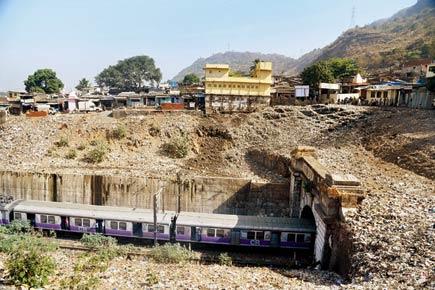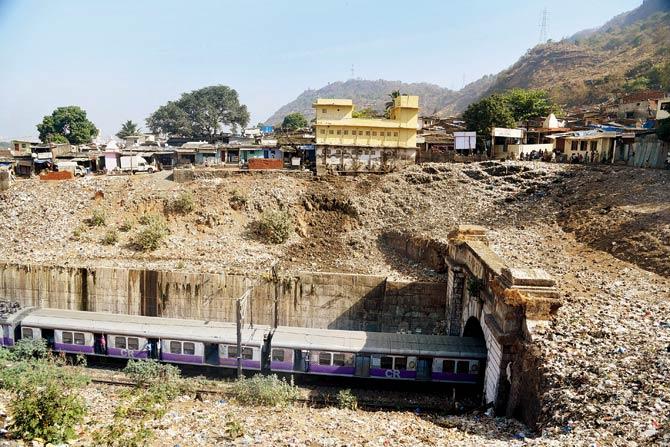Condition of Parsik tunnel, created in 1873, has deteriorated to the extent that there are multiple leakages inside the tunnel where water spurts onto the passing train and its ceiling is cracked right beneath the rocky hill

In 1873 one of the oldest rail tunnels in Asia connecting Mumbai with its distant suburbs — Parsik tunnel — was created. Now its condition has deteriorated to the extent that there are multiple leakages inside the tunnel where water spurts onto the passing train and its ceiling is cracked right beneath the rocky hill. The Central Railway (CR) plans to repair it.
ADVERTISEMENT

Trains play between Thane and Dombivli, and Kalwa and Mumbra stations through the tunnel. Pic/Sameer Markande
Sources said that over the years there have been lot of illegal slums and structures that have cropped up above this rail tunnel. “Earlier there were trees that now have been replaced by slums. We have built walls to prevent slums from coming near the tracks,” said a CR official.
Although regular demolition drives are carried out by civic bodies, the number of slums are growing upwards on top of the Parsik hill. Apart from the several toilet blocks there, the dwellers also throw garbage on rail tracks. The officials also stated that during monsoon the water stream seeps through the cracked ceiling of this tunnel and has now weakened it.
“It is like a waterfall inside the tunnel. The track on which fast trains pass is more affected,” said Madhu Kotian, president, Mumbai Rail Pravasi Sangh. The deforestation has added to the plight as soil erosion above the tunnel only created more leakages.
The tunnel catering to the fast lines is 1.3km long —wherein trains ply between Thane and Dombivli stations — while the tunnel on the slow line is barely 100 metres long or so. It is between Kalwa and Mumbra stations.
“We will be putting a 5mm thick cement layer and create a channel for diverting the water,” said another CR official. The officials added that they cannot prevent the water flow above the Parsik tunnel during monsoon or otherwise and the only way is to channelise water leakage.
This new coating will be above the overhead wires that supply electricity to trains and on the existing flaky cracked layer inside the tunnel. The authorities claim that they cannot enlarge the coating due to the 25,000 volt Alternating Current cables with needs to maintain sufficient gap from the train’s coach.
In June 2015, the Central Railway authorities completed power upgradation between Thane and Kalyan from 1,500 volt DC to 25,000 volt AC. During this period the authorities not only lowered the tracks inside Parsik tunnel but also put speed restrictions for trains. The officials agreed that water leakages added to the problem for commuters who normally complain of getting wet from the seeping water inside the tunnel.
“On an average each train loses three minutes due to the speed restriction inside the tunnel,” said another CR official.
The CR had approached an external agency, the Central Institute of Mining and Fuel Research (CMRI), for studying the tunnel’s condition and they had suggested that the mouth of these seepages coming from the hill be blocked, but then the Railway engineers decided to have this 5mm cement layer as it is possible that the crack in the tunnel might spread.
The CR authorities have not yet decided when the work will be carried out. However they claim it could be possible for the work to be carried out during a night of a mega block when train services are shut.
 Subscribe today by clicking the link and stay updated with the latest news!" Click here!
Subscribe today by clicking the link and stay updated with the latest news!" Click here!






